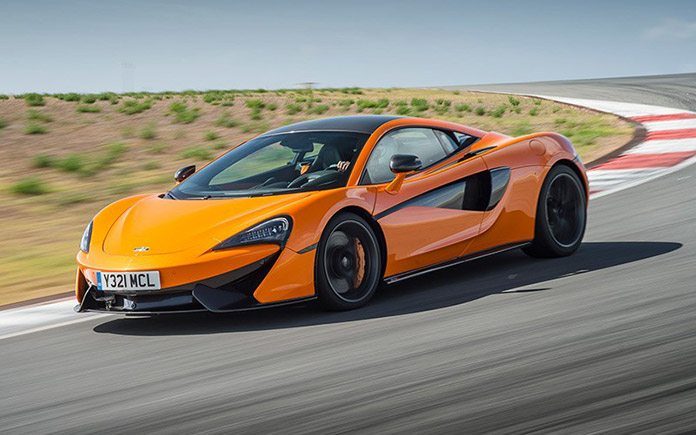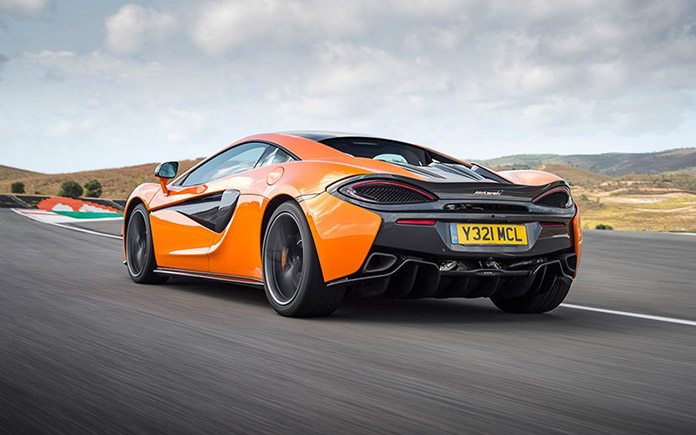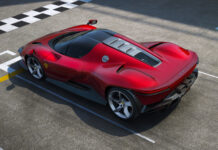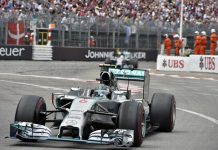The McLaren 570S Coupé demonstrates five key characteristics – aerodynamics and design, minimised weight, craftsmanship, day-to-day usability and driving involvement – to create the most attainable McLaren model to date
The McLaren 570S Coupé is the first – and highest powered – model launched in the recently announced Sports Series. Following its global debut at the New York International Auto Show in April 2015, the new model range marks the entry of McLaren into the luxury sports car market, introducing race-derived technologies and supercar performance in a package which is very much a pure McLaren.
Lightweight construction, including the use of a carbon fibre chassis, recognisable design values and a comprehensive specification list ensures a class-leading offering, and as uncompromised as is expected from a McLaren. With pricing starting at £143,250, the 570S Coupé is available to order now with deliveries depending on market starting before the end of 2015 – the 540C Coupé, which retails from £126,000, follows in Q2 2016.
The latest addition to the range completes the three tier model strategy for McLaren alongside the Super Series and Ultimate Series. The Sports Series is the most usable and attainable model to wear a McLaren badge to date, but it retains the core design and dynamic focus that ensures it is still worthy of the iconic name. Weighing as little as 1,313kg (2,895lbs), thanks in part to the unique lightweight carbon fibre MonoCell II chassis, the Sports Series is almost 150kg lighter than its closest rival.
Power is provided by an evolution of the 3.8-litre twin turbo V8 engine with 30 percent new components. This ensures electrifying performance, with the 570S boasting a class-leading power-to-weight figure of 434PS. At the same time, the interior is more tailored around day-to-day usability, with optimised access, greater levels of stowage space and more refinement.
The Sports Series is a showcase of modern craftsmanship, with each model hand-finished at the state-of-the-art McLaren Production Centre (MPC) in Woking, England. A suite of new optional content and a ‘By McLaren’ designer range of interiors highlight the levels of customisation available.
‘The Sports Series is aimed at a new audience for McLaren,’ explains Mike Flewitt, Chief Executive Officer, McLaren Automotive. ‘It is the first time we’ve competed in the sports car as opposed to the supercar market. As with all McLaren models, we have prioritised performance, driving engagement and exhilaration.
It is a totally driver-focused car, with excellent ergonomics and visibility, and a class-leading driving position. This is also the most day-to-day usable, practical and attainable McLaren we’ve ever made. It is a dramatic and beautiful sports car.’
Chris Goodwin, McLaren Chef Test Driver adds: ‘For the Sports Series we wanted to offer a real sports car feel. Ultimately, it means a car that feels nimble, agile and it must also possess a lightness and directness of response to a driver’s inputs. Certainly for us, a sports car really needs to engage the driver, at any speed.’
THE McLAREN 570S COUPE: THE DETAILS
The McLaren Sports Series is the third and final product family to join the recently announced three tier model range from McLaren Automotive. A pure McLaren from the ground up, the Sports Series launches in coupé bodystyle with two models – the first, and most powerful, is the 570S Coupé, which will be joined by the more accessible 540C Coupé from Q2 in 2016.
These models complete the range alongside the Ultimate Series, comprising the McLaren P1 and McLaren P1 GTR, and the Super Series, which is the core McLaren range featuring the 650S, available as a Coupé and Spider, and the 675LT.
The Sports Series introduces the unique McLaren DNA to the sports car market. Each model has been designed and engineered by a team of experts at the iconic McLaren Technology Centre (MTC) alongside the Formula 1™ team operations, and every car is hand built in the state-of-the-art McLaren Production Centre (MPC) alongside the current range.
As with every McLaren model designed for road or track since 1981, the Sports Series range is built around a lightweight carbon fibre chassis. High performance and high efficiency is also delivered through a mid-mounted twin-turbocharged V8 engine. With no compromises, the Sports Series is the perfect entry point into the world of McLaren.
DESIGN AND AERODYNAMICS
‘The air-piercing front bumper separates airflow into four directions, with each path being worked over, under and through the sculpted bodywork. The beautiful organic form, with features including the door tendon and flying buttress work with the fixed rear wing to optimise aerodynamics’
Rob Melville, Chief Designer
- ‘Shrink wrapped’ design maximises efficiency of the airflow over, under and through the bodywork with a fixed aerodynamic package
- Aerodynamically-optimised dihedral doors feature ‘floating’ tendons to channel the flow of clean air
- Elegant flying buttresses provide increased levels of downforce and enhanced cooling
The Sports Series introduces the McLaren design language to the sports car segment for the first time, with tense, ‘shrink wrapped’, body lines marking it out from the competition. Design cues and learnings from models in the Ultimate and Super Series ensure the Sports Series looks every part a true McLaren, but with a clear identity of its own. Key design features include elegant flying buttresses, dihedral doors and a concave rear window to bring a new, unique and exciting look to the sports car segment.
The final design of the 570S Coupé is closely matched to the initial design sketches first proposed by Chief Designer Rob Melville and his team at the outset of the project. Clean, sweeping lines, and an uncluttered exterior have a clear focus on the way air flows over the sculpted panels, channelling air around the tightly packaged glasshouse, over and, in some areas, through the bodywork.
Dynamic styling provides visual presence and is based around functional elements. This approach combines fluid surfaces and strong features to deliver a final aerodynamic shape designed to optimise air flow management in, out and around the vehicle. Weight is minimised through the layering of panels, designed to float above aerodynamic surfaces along with suspended members, supporting the potency of this compact sports car.
FIXED AERODYNAMIC PACKAGE
The front bumper on the Sports Series is crucial to how the air interacts with the bodywork as it travels from the front to the rear. The design dictates how air is controlled before passing over, under and through the vehicle. The front bumper has a pronounced point which generates the centre of pressure, piercing the air to reduce drag and forming four quadrants.
The air is divided above and below the bodywork, and also to either side. The strong crease lines along the bonnet add design definition and, more importantly, aid air flow over the doors and into the side air intakes to help cool the high temperature radiators – a principle used in Formula 1™. Below the front bumper are Aero Blades, angled specifically to create an area of high pressure ahead of the low temperature radiators.
At the rear, the sculpted rear fenders merge to form a level rear deck, where the engine plenum cover is visible through open, hexagon shaped mesh vents designed to aid heat evacuation. The trailing edge of the rear deck features an integrated fixed spoiler designed for an optimised balance of drag and downforce. The surfaces leading to the trailing edge have been designed to be as streamlined as possible, ensuring clean airflow to provide enhanced levels of downforce.
DIHEDRAL DOORS FEATURE ‘FLOATING’ TENDONS
Every McLaren road car since the iconic McLaren F1 from the 1990s has included distinctive dihedral doors, and the Sports Series continues the design tradition. The advanced and intricate door design is inspired by those on the McLaren P1™, and features a ‘floating’ tendon which works to channel air into the ultra efficient air intake. This supplements the side intakes that directly feed the HTRs (high temperature radiators) which, in turn allows for smaller side intakes, reducing drag.
Every effort has been made to optimise aerodynamic performance on the Sports Series. An example of this is evident in the design of the wing mirror arms, which improve cooling efficiency by two percent. This aerodynamic gain has been achieved through minimising the cross sectional area of the wing mirror arms while also studying how best the airflow from the vehicle and mirrors interact.
Further evidence aerodynamic efficiency can be seen with a tyre spoiler on the leading edge of the wheel arch and side skirts running down each flank. These work in conjunction to ‘clean’ the airflow as it passes around the front wheel arches and travel rearwards.
FLYING BUTTRESSES
The ‘shrink wrapped’ design of McLaren Sports Series carefully channels airflow over every panel. The rear of the glasshouse on the Sports Series features unique floating C-pillars, allowing air to follow the shape of the cabin, and flow beneath. The elegant flying buttress design of the Sports Series Coupé body has been aerodynamically optimised to primarily counteract lift over the roof.
The airflow channelled through the buttress equalises the areas of low pressure created by the convex roof, increasing downforce. In addition, this feature also minimises drag, and increases the flow of cool, clean air over the engine bay to optimise powertrain heat management.
A further distinctive feature of the Sports Series Coupé models is a concave rear windscreen which sits between the flying buttresses. Together with new thinner B-pillars, this design ensures excellent visibility from within the Sports Series – something McLaren models are renowned for – especially for a mid-engined sports car where rear and rear-three-quarter vision can often be compromised.
REAR DIFFUSER
Airflow management is key to the Sports Series, from the front bumper through the integrated rear spoiler. Below this sits an intricate rear diffuser, unrivalled in its class for complexity and effectiveness. Efficiency is maximised with the underside of the Sports Series being completely flat, feeding clean air to the rear of the vehicle and the aggressive diffuser. As in Formula 1, the careful management of air flowing below the car allows ‘ground effect’ aerodynamic optimisation to ensure further downforce is harnessed.
LED LIGHTING
As standard, the Sports Series uses LED lighting across the range at the front and rear. The design of the front light units reflects the McLaren ‘Speed Mark’ logo, with LED daytime running lights (DRLs) following the edge of the unit to create a distinctive visual signature. The lights are automatically activated and include ‘Follow Me Home’ and ‘Overseas Tourist’ functions.
The later allows easy adjustment between left- and right-hand drive markets. The rear light signature incorporates the turn signal, and follows the trailing edge of the rear body panels giving the illusion that the panel is floating.
LIGHTWEIGHT
‘With a carbon fibre chassis and lightweight superformed aluminium bodywork, the 570S Coupé tips the scales at just 1,313kg, making it more than 140kg lighter than its nearest rival’
Mark Vinnels, Executive Director – Product Development
- Class-leading power-to-weight figure of 434PS per tonne
- Unique carbon fibre MonoCell II features a lower, narrower sill to aid cabin access; weighs 75kg
- ‘Superformed’ aluminium body panels are used for the first time on a McLaren, allowing for more complex designs and ensuring optimised weight
The Sports Series is the only model range within the sports car segment to offer a full carbon fibre chassis. This lightweight component, and the use of aluminium for the majority of the body panels ensures that weight is kept to a minimum. The dry weight of the 570S Coupé is just 1,313kg, giving a class-leading power-to-weight figure of 434PS per tonne
CHASSIS
As with every McLaren designed and developed for the road or track since 1981, the heart of the Sports Series is a lightweight carbon fibre chassis. While similar to the chassis in the Super Series, the MonoCell II is unique. It has been newly designed with more of a focus on day-to-day usability, with the narrower front sill and height reduced by 80mm to offer improved ingress to and egress from the cabin. As is inherent with carbon fibre construction, the chassis is incredibly strong and stiff yet weighs 75kg, offering optimum levels of protection.
The carbon fibre MonoCell II is 25 percent stiffer than a comparable aluminium chassis, and has an even greater margin of superiority over steel. This structural stiffness improves handling, agility and ride comfort. It is stronger and safer in a crash, and needs no extra bracing or reinforcement (such as side intrusion beams).
The carbon fibre has enough intrinsic strength without ‘bolt on’ safety beams. It is also more durable than metal, and its greater dimensional accuracy improves build quality.
As part of this development, the front and rear aluminium structures have also been revised, fine tuning load paths into the new carbon structure, accommodating the new anti-roll bar positions, and to reduce complexity and inevitably weight.
There are also advantages in ease of repair. Front and rear aluminium extrusions and castings are designed to absorb impacts and are easily fixed. Cars with full aluminium or steel chassis use their structures to absorb and crumple on impact, causing more damage and expense to the entire structure.
BODYWORK
Aluminium is utilised for the majority of body panels on the 570S Coupé. Through a process called ‘Superform’ – where hot aluminium is blown into shape over a mould – the lightweight material can be formed into detailed design features, such as the intricate rear deck. Through this method, this component weighs the same as a composite equivalent.
The dihedral doors are produced primarily from aluminium to minimise weight and allow for the intricate aerodynamic design. The upper ‘floating’ tendon is manufactured using a resin injection process to deliver an extremely rigid yet slender component, along with a lightweight core to minimise weight. To keep the exterior surfaces clear, the door is opened using the button located on the lower edge of the tendon.
WHEELS
The Sports Series is launched with a range of newly designed wheels. The 570S Coupé is fitted as standard with fourteen-spoke lightweight forged wheels, 19-inch at the front, and 20-inch at the rear. Two Super Lightweight designs, in either five- or 10-spoke offer a combined 7kg weight saving. Each design has a silver finish as standard, but can be specified with a Stealth and Diamond Cut finish as an option.
THE DRIVE
‘We have worked hard on each of the touchpoints within the cabin to ensure the Sports Series is the most accessible McLaren model to date – not only in terms of price, but it allows a wider range of drivers to enjoy, and push, the limits of the car’ says Chris Goodwin, Chief Test Driver
- Class leading power-to-weight ratio of 434PS per tonne gives breathtaking performance; 0-100km/h (0-62mph) in 3.2 seconds; 0-200km/h (124 mph) in 9.5 seconds
- Performance Traction Control incorporates bespoke McLaren software to deliver more precise control in extreme situations
- Newly-developed suspension system uses adaptive dampers and anti-roll bars to ensure enhanced levels of driver engagement and refinement on both road and track
The Sports Series offers unrivalled performance and driving exhilaration in the sports car class. It is the only car in its sector to offer all the credentials typically found in the top-tier supercars: lightweight carbon fibre chassis construction, mid-engine rear wheel drive configuration. Overall performance for the 570S Coupé is class-leading with the 0 to 100 km/h (0-62 mph) sprint taking 3.2 seconds, while 200 km/h is reached in just 9.5 seconds. Top speed is 328 km/h (204 mph).
A dry weight of 1,313kg (2,895lbs) is around 140kg (309lbs) lighter than the nearest rival. This low weight ensures optimised handling, agility and makes the Sports Series even more responsive.
STEERING
The steering in the Sports Series has been designed with refinement and feel as the key parameters. A fast steering rack ratio allows quick changes of direction and improves ease of control when driving at the limit – pivotal to a great sports car. As with the models in the Super Series and Ultimate Series ranges, the system used for the Sports Series is electro-hydraulic ensuring a natural feel that cannot be replicated with a fully electric setup.
The electro-hydraulic pump also powers the optional front lift system – which allows the ride height to be increased by 40mm at speeds of up to 60km/h (37mph). A one touch short-cut to raise the vehicle is available through the steering wheel-mounted menu stalk.
TYRES DEVELOPED WITH PIRELLI
As with the all models in the McLaren range, the tyres for the Sports Series have been tested continuously throughout the development programme specifically in conjunction with technical partners Pirelli. The design brief was focused on balance and agility, with a view to create a tyre with progressive levels of grip allowing the driver to explore the limits of the car with total confidence.
‘We have worked closely with Pirelli throughout the programme to design a bespoke tyre to best suit the Sports Series, and it is a really important partnership. Being the only contact with the road, the tyre is critical to how the car handles and behaves, and we treat them in the same way as any key suspension component. They are specially tuned and developed with Pirelli, and that makes a huge difference to the dynamics of this car’ explains Goodwin.
The 570S Coupé is fitted with performance-focused Pirelli P Zero Corsa tyres as standard, while a Pirelli P Zero is available as a no-cost option. Tyre sizes are 225/35/R19 on the front and 285/35/R20 on the rear. The P Zero Corsa tyres have been developed with stiffer sidewalls and treads, offering outstanding grip levels, and yield advantages on a circuit and in standing-start acceleration. The P Zero option provides optimum performance levels in extreme wet and cold conditions.
BRAKING SYSTEM
The 570S Coupé is equipped as standard with carbon ceramic discs (front: 394mm x 36mm / rear: 380mm x 34mm), with six-piston callipers on the front and four-piston callipers at the rear. Newly developed ABS software is also present, and bespoke to the Sports Series, which has been designed to optimise brake feel. This new system also reduces pulsing through the pedal.
A new ESC (Electronic Stability Control) system, developed with Bosch, includes a new ‘Dynamic’ mode which provides reduced intervention, to allow greater vehicle control on the limit and ‘driftability’. The ESC system for the first time includes a dedicated control switch, allowing ESC control independently to the handling control dial.
This allows the choice of full, dynamic or ESC-off when in Sport and Track handling modes. With an improved pump and dual valve system, the ESC system is refined and provides greater resolution and thus more progressive control.
Also new to the Sports Series is a new Performance Traction Control, which incorporates bespoke McLaren software to deliver more precise control in extreme situations. In Dynamic mode, the traction control allows a gradual transition at the point of slip (YAW angle) and therefore more confidence to explore the Sports Series at the limits of its handling.
The McLaren Sports Series features a number of Formula 1™-derived technologies, including the Brake Steer system. Initially developed by McLaren during the 1997 season, and subsequently banned due to the significant performance advantage offered, the system aids cornering by bringing the vehicle’s nose into the apex by applying braking force to the inside rear wheel. This enables the driver to brake later and get on the power earlier.
SUSPENSION
The Sports Series is fitted with a newly-developed suspension system ensuring enhanced levels of driver engagement and refinement on both road and track. The system uses independent adaptive dampers with front and rear anti-rollbars – distinct from the Super Series and Ultimate Series – and Formula 1™-style dual wishbones.
Adaptive dampers offer control over bump and rebound settings using the familiar McLaren ‘Normal’, ‘Sport’ and ‘Track’ handling settings, with the 570S Coupé having bespoke damper settings to other McLaren models to date. In ‘Normal’ mode, the system provides a refined yet engaging ride, while the ‘Sport’ and ‘Track’ settings allow the 570S Coupé to become more track-focused when required. Twin damper valves give precise control, while dual wishbone suspension provides optimum suspension travel and geometry.
Chris Goodwin added: ‘For a sports car, it is more about the grip balance and the response of the tyres and the response of the steering. The Sports Series has narrower tyres than the models in the Super or Ultimate Series, and the car still has high enough objective performance, but it is also about the subjective feel.
It is hard to measure subjective performance, but how big the smile on the drivers face is when he goes round a corner is always a good measure. We have used the suspension geometry and set-up to create a balance that makes the car really want to turn in to a corner. It feels like all you have to do is look at the apex of the corner and the car is sucked into it.’
POWERTRAIN
- 3.8-litre twin turbo V8, with 30 percent of components bespoke to the new model, produces 570PS (562bhp) and 600Nm (443 lb ft)
- Stop-start system fitted for the first time on a McLaren offers greater efficiency during city driving, improving fuel consumption and CO2 output
- Optimised gearchanges through seven-speed seamless-shift gearbox (SSG) with ‘Cylinder Cut’ technology
The Sports Series features an evolution of the 3.8-litre V8 twin turbo engine, named M838TE, with 30 percent of components bespoke to the new model. Engineered by McLaren, it produces 570PS (562 bhp) at 7,400 rpm, and 600Nm (443 lb ft) of torque at 5,000-6,500 rpm. The classic mid-engine rear-wheel drive supercar configuration optimises handling and agility – except that it competes in the sports car, not the supercar, market – delivering power through a seven-speed seamless shift gearbox (SSG).
Despite being one of the world’s most powerful road car engines, it is also extremely efficient. A new stop-start system seen for the first time at McLaren provides greater efficiency during city driving, improving fuel consumption and CO2 output. The 570S Coupé returns 26.6 mpg (10.7 litres/100km) on the EU combined cycle with an improved range, while emissions are just 249g/km.
Other improvements to the efficiency of the powertrain include new 60-degree camshaft phase controllers that reduce internal engine inertia and provide greater control, both benefitting CO2 figures and engine response. The vacuum system has also been deleted from the engine which saves 2.5kg and reduces complexity.
Sharing technology with the Super Series, the M838TE engine includes Formula 1™ technology such as dry sump lubrication – to enable higher cornering speeds without oil surge – and a flat-plane crankshaft, to allow the engine to be sited as low as possible to improve the centre of gravity and both handling and agility.
ExxonMobil ensures each groundbreaking McLaren model benefits from the highest levels of technical commitment and expertise. The Sports Series joins the Super Series and Ultimate Series in being factory-filled with New Life™ 0W-40 developed by McLaren Automotive technology partner Mobil 1. The high technology engine lubricant has an optimum combination of synthetic base oils designed to meet the high performance engine demands.
The advanced formula contains additives specially developed to better protect the engine by preventing build-up on critical engine parts, allowing McLaren engines to run like new after thousands of miles, even in the harshest driving conditions.
The Sports Series is fitted with new equal length exhaust manifolds produced from cast stainless steel mounting sections mated to stainless steel hydroformed tubes. These optimise exhaust flow and provide a performance advantage in terms of consistent, uniform back pressure, while also delivering a new, distinctive crisp exhaust note.
TRANSMISSION
The Sports Series uses the same seven-speed twin-clutch SSG (Seamless Shift Gearbox) as seen in the Super Series, offering ‘Normal’, ‘Sport’ and ‘Track’ modes. The settings have been recalibrated to produce faster shifts, achieved through new control strategies, focusing on the rate of engine speed transitions. New advanced throttle control during shifts ramps up or down engine speed with greater urgency.
‘The sense of engagement with the car during gearshift as well as when accelerating and decelerating is key in delivering the exhilarating feel for the McLaren Sports Series,’ says Mark Vinnels, Executive Director – Product Development. ‘It is also key to delivering exhilaration throughout the performance envelope of the car, not just when the driver might be seeking the fastest lap time, for example.’
‘Cylinder Cut’ technology, first seen on the 650S for upshifts, has been further enhanced to activate on both upshifts and downshifts, now utilising the engine ignition control it can act up to 10 times faster than previously.
To provide the greatest sense of interaction and performance during all driving situations three control strategies have been developed; Powershift, GT3 Shift and ‘Inertia Push’.
The Sports Series uses the innovative ‘Inertia Push’ technology – again pioneered on the 650S. Available in Track mode – above 5000rpm and from 60 percent throttle input – the system harnesses the inertia of the flywheel to deliver an impulse of torque as the next gear is engaged.
As on the 650S, this approach delivers the next gear before the engine speed has dropped, resulting in continual strong acceleration, with no drop in the rate of acceleration as the driver upshifts.
For the first time, the gearbox clutch control has been separated from the engine control, to enhance refinement. This helps produce quicker gear changes.
CRAFTSMANSHIP
‘As we move forward as a business we take learnings from previous projects and current products, and now moving into the sports car sector, the programme has become the most challenging to date as we push the bar of quality and performance even higher’ says Andreas Bareis, Executive Director – Quality
- ‘By McLaren’ designer interiors offer the ultimate vehicle specification with a Sport or Luxury focus
- Hand assembled in the state of the art McLaren facility in Surrey, England
- Each car takes 188 man hours to build by a team of 370 highly trained assembly and quality technicians
The Sports Series represents the most attainable McLaren models to-date, and also offers the highest level of personalisation. Bespoke ‘By McLaren’ specifications offer a mix of sports or luxury finishes within the cabin in conjunction with a broad colour palette available externally. In addition to this, the widest variety of optional equipment ever offered by McLaren allows owners to individually tailor seating, interior finishes, upholstery and audio systems.
EXTERIOR
For the first time on a McLaren road car, the models in the Sports Series primarily feature aluminium body panels rather than composites or carbon fibre. This change reflects the higher production volumes, with aluminium offering superior quality of finish – especially in surfacing – for larger production numbers. A typical downside is that it gives less design freedom, for complex shapes, than moulded composite or carbon fibre panels.
Utilising a new ‘Superform’ method – in which hot aluminium is blown into complex shapes over a mould – has allowed McLaren to produce intricate parts, most notably the large rear deck, which also reduces weight. Aluminium is used for the front and rear fenders, bonnet, rear deck, lower sections of the dihedral doors and roof. The upper section of the doors including, ‘tendons’ and front splitter, are made from composite.
A range of optional visual carbon fibre upgrades, echoing the lightweight chassis, are available for the 570S Coupé. The front Aero Blades, Side Skirts, door insert, Side Intake and rear diffuser can all be specified in carbon fibre.
INTERIOR
The interior design of the 570S Coupé carries the exterior design approach through with key features including floating elements to add to the sense of depth, while organic shapes and curves bring delicate tension without aggression for a welcoming and ergonomic layout. The space has been created to ensure superb outward visibility and enhanced interior space for occupants both in terms of seating position and stowage space.
The feeling of luxury and airiness is heightened by the use of a ‘floating’ centre console, to add a sense of depth to the cabin. Shapes and lines seamlessly integrate from exterior to interior, and vice versa. The facia and door trim incorporate floating elements which remove mass – both visually and practically – as well as adding layered depth and integrated components such as the audio speakers and the touchscreen IRIS system.
Interior components and switchgear are ergonomically designed and finished to the highest standard further enhancing the feel of quality and craftsmanship throughout the cabin. Rotary switches, buttons and steering wheel mounted stalks are all tactile to touch, while a seven-inch touchscreen is intuitive and the most advanced infotainment system to feature in a McLaren model to-date.
The ‘floating’ screen is not connected to the lower transmission tunnel – as is the case with models in the Super Series and Ultimate Series – giving enhanced access to the stowage space and cupholders below the dashboard. It is also mounted in portrait view, rather than the more conventional landscape, bringing the occupants closer to the centreline of the car to further optimise response and agility.
Air conditioning is controlled via the screen reducing the amount of switchgear and controls in the cabin environment. The touchscreen also controls the standard DAB digital radio (or Sirius satellite radio in North America), as well as satellite navigation, Bluetooth telephony and media streaming, voice activation and the audio media player. The IRIS system also includes the electronic owner’s manual.
The interior of the Sports Series can be upholstered in a wider range of leathers and Alcantara® options than previously available. Extended Leather is standard on the 570S Coupé, available in four themes – Carbon Black, Saddle Tan, Scoria Grey and Midnight Blue. In addition the 570S Coupé is available with four further interior levels: Nappa Sport Leather, Nappa Design Leather, Nappa Sport Alcantara and one of 10 unique ‘By McLaren’ colour and trim combinations.
‘BY McLAREN’ INTERIOR CUSTOMISATION
First shown on the 675LT at the 2015 Geneva Motor Show, the ‘By McLaren’ designer interiors demonstrate the full breadth of interior customisation possibilities. They introduce unique colours and materials which are not offered through the other optional specifications, with up to three co-ordinated colours per design.
The Sports Series offers the widest selection of ‘By McLaren’ designs to date, with 10 in total. Of these, five have a focus on contemporary luxury, while the other five have a more sports focus and can be specified with optional Racing Seats. All designs have been selected by the in-house design team at McLaren Automotive to accentuate the interior design while also taking into account exterior colour choice to provide the ultimate cohesive vehicle specification.
SEATING
New seats in the Sports Series offer increased levels of support and comfort. As standard, the seats are six-way adjustable for the driver, including electric height adjustment, four-way for the passenger, and are fully upholstered in leather. Four further upholstery options are available, giving increased levels of customisation and comfort with Nappa Sport, Nappa Design, Nappa Alcantara® and ‘By McLaren’ specifications.
Fully electric eight-way adjustable seats with heating and memory function can be specified as an option. A comfort entry / exit feature is also available to provide the maximum amount of room to enter or exit the car, by moving the seat to its lowest and most rearward position and retracting the electric steering column.
Carbon fibre shelled racing seats, as featured in the McLaren P1™ are also available. These fixed back manually adjustable bucket seats offer significant support with a provision for harnesses to be fitted. These lightweight seats provide a substantial 15kg weight saving.
AUDIO
As with all McLaren audio systems, extensive in-cabin tuning has taken place for the audio systems available for the 570S Coupé. The standard four-speaker, which boasts an excellent quality-to-weight ratio, is the lightest audio system ever fitted to a McLaren. Two dual-voice coil 165mm bass woofers capture mid-low frequencies while two high performance tweeters provide clarity to any range of audio genre’s. The system is powered by a 240W Class AB amplifier.
Two audio upgrades are available for the Sports Series, with eight- and 12-speaker systems offering additional power and speaker channels to produce a more immersive aural experience.
In addition to the standard system, the eight-speaker McLaren Audio Plus system adds two 100mm mid / bass drive units, and two 25mm tweeters in the rear of the cabin. The amplifier is also upgraded to a 320W Class AB rating.
The addition of the 100mm units adds to the clarity and depth of the sound, while the extra tweeters balance the sound to ensure the occupants have a greater sense of immersion in the audio.
The range-topping 12-speaker system, developed in conjunction with British audio specialists Bowers & Wilkins, delivers the cutting edge of audio technology into the Sports Series.
Of particular note, Bowers & Wilkins has derived the high-frequency driver design in the 570S Coupé from the flagship model, Nautilus. Each of the system’s five tweeters features a spiral diffuser, made famous by the Nautilus. This soaks up reflected sound waves from the rear of the drive unit, and helps produce a sound that’s superbly detailed, unadulterated and free from colouration.
Furthermore, one of the tweeters is strikingly integrated into the centre of the dashboard. This ‘tweeter-on-top’ design is a key feature of Bowers & Wilkins high-end loudspeaker ranges, and results in remarkably open sound imaging and stereo performance.
This audio critical placement is mirrored in all the other drive units; to ensure a coherent, immersive audio experience all are placed in the optimal position, to ensure sound reflections are minimised and acoustic performance optimised.
Materials have also been carefully selected: the Kevlar(r) midrange speaker cones guarantee constant dispersion across the frequency range, while the lightweight subwoofers are extremely stiff for perfect pistonic behaviour, ensuring completely undistorted bass.
The system comprises five 25mm aluminium Nautilus tweeters, five 100mm Kevlar® mid-range drive units and two 200mm carbon fibre & Rohacell bass subwoofers, All speakers are driven by a fully digital 14-channel 1280W Class D amplifier.
The result is a system that is perfectly configured for the specific environment of the 570S Coupé.
WHOLE LIFE COSTS
With the launch of the Sports Series, McLaren has launched its most attainable model to-date with a starting price of £126,000 for the 540C Coupé and £143,250 for the 570S Coupé. As important as the initial purchase price is the overall cost of ownership and servicing, and the Sports Series delivers on this front as well, with the lowest running costs of any McLaren to date.
The highly efficient powertrain, with low weight 3.8-litre twin turbo V8 engine returns 26.6 mpg (10.7 l/100km) on the EU combined cycle, with emissions of just 249 g/km. As with all McLaren models, these figures ensure the Sports Series range is exempt from gas guzzler tax in North America. The unique calibration and set up offers a more usable sportscar, suited to daily driving, with more of a focus on road driving, and an extended fuel range of around 10 percent over the 650S models.
As with all McLaren models, the Sports Series has an annual service schedule to ensure it is continually updated with the latest software developments and improvements. These scheduled services require the lowest level labour and parts than in any previous McLaren model, ensuring that costs have been reduced to less than half the cost of the original 12C when it launched in 2011. Engine oil replacement intervals are every two years / 15,000km, whichever comes first – whichever comes first
With aluminium used extensively throughout for the body panels, this is easier to repair than the composite seen on previous McLaen models. As a result, repair work is easier and lower cost in the event of any accident.















